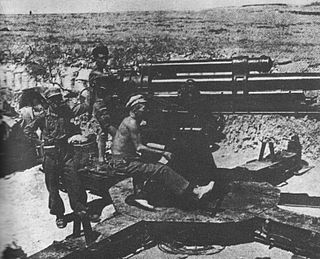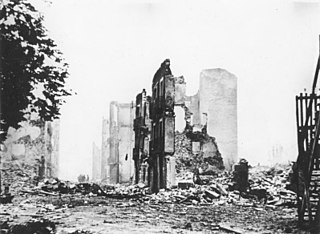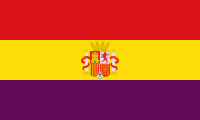
The Battle of the Ebro was the longest and largest battle of the Spanish Civil War and the greatest, in terms of manpower, logistics and material ever fought on Spanish soil. It took place between July and November 1938, with fighting mainly concentrated in two areas on the lower course of the Ebro River, the Terra Alta comarca of Catalonia, and the Auts area close to Fayón (Faió) in the lower Matarranya, Eastern Lower Aragon. These sparsely populated areas saw the largest array of armies in the war. The battle was disastrous for the Second Spanish Republic, with tens of thousands left dead or wounded and little effect on the advance of the Nationalists.

Juan Negrín López was a Spanish physician and politician who served as prime minister of the Second Spanish Republic. He was a leader of the Spanish Socialist Workers' Party and of the left-leaning Popular Front government during the Spanish Civil War. He also served as finance minister. He was the last Loyalist premier of Spain (1937–1939), leading the Republican forces defeated by the Nationalists under General Francisco Franco. He was President of the Council of Ministers of the Second Spanish Republic and the Spanish Republican government in exile between 1937 and 1945. He died in exile in Paris, France.

The Spanish Civil War (1936–1939) broke out with a military uprising in Morocco on July 17, triggered by events in Madrid. Within days, Spain was divided in two: a "Republican" or "Loyalist" Spain consisting of the Second Spanish Republic, and a "Nationalist" Spain under the insurgent generals, and, eventually, under the leadership of General Francisco Franco.

The Battle of Brunete, fought 24 kilometres (15 mi) west of Madrid, was a Republican attempt to alleviate the pressure exerted by the Nationalists on the capital and on the north during the Spanish Civil War. Although initially successful, the Republicans were forced to retreat from Brunete after Nationalist counterattacks, and suffered devastating casualties from the battle.

The Moscow Gold, or alternatively Gold of the Republic, was 510 tonnes of gold, corresponding to 72.6% of the total gold reserves of the Bank of Spain, that were transferred from their original location in Madrid to the Soviet Union a few months after the outbreak of the Spanish Civil War. This transfer was made by order of the government of the Second Spanish Republic, presided over by Francisco Largo Caballero, through the initiative of his Minister of Finance, Juan Negrín. The term also encompasses the subsequent issues relating with the gold's sale to the USSR and the use of the funds obtained. The remaining quarter of the Bank's gold reserves, 193 tonnes, was transported and exchanged into currency in France, an operation which is also known by analogy as the "Paris Gold".
The international response to the Spanish Civil War included many non-Spaniards participating in combat and advisory positions. The governments of Italy, Germany and, to a lesser extent, Portugal contributed money, munitions, manpower and support to the Nationalist forces, led by Francisco Franco. Some nations that declared neutrality favored the nationalists indirectly. The governments of the Soviet Union and, to a lesser extent, France and Mexico, aided the Republicans, also called Loyalists, of the Second Spanish Republic. The aid came even after all the European powers had signed a Non-Intervention Agreement in 1936. Although individual sympathy for the plight of the Spanish Republic was widespread in the liberal democracies, pacifism and the fear of a second world war prevented them from selling or giving arms. However, Nationalist pleas were answered within days by Adolf Hitler, Benito Mussolini and António de Oliveira Salazar. Tens of thousands of individual foreign volunteers travelled to Spain to fight, the majority for the Republican side.

The Aragon Offensive was an important military campaign during the Spanish Civil War, which began after the Battle of Teruel. The offensive, which ran from March 7, 1938, to April 19, 1938, smashed the Republican forces, overran Aragon, and conquered parts of Catalonia and the Levante.

The Catalonia Offensive was part of the Spanish Civil War. The Nationalist Army started the offensive on 23 December 1938 and rapidly conquered Republican-held Catalonia with Barcelona. Barcelona was captured on 26 January 1939. The Republican government headed for the French border. Thousands of people fleeing the Nationalists also crossed the frontier in the following month, to be placed in internment camps. Franco closed the border with France by 10 February 1939.

During the Spanish Civil War, several countries followed a principle of non-intervention to avoid any potential escalation or possible expansion of the war to other states. That would result in the signing of the Non-Intervention Agreement in August 1936 and the setting up of the Non-Intervention Committee, which first met in September. Primarily arranged by the French and the British governments, the committee also included the Soviet Union, Fascist Italy, and Nazi Germany. Ultimately, the committee had the support of 27 states.

Red Terror is the name given by historians to various acts of violence committed from 1936 until the end of the Spanish Civil War by sections of nearly all the leftist groups involved. News of the rightist military coup in July 1936 unleashed a politicidal response, and no Republican controlled region escaped systematic and anticlerical violence, although it was minimal in the Basque Country. The violence consisted of the killing of tens of thousands of people, attacks on the Spanish nobility, small business owners, industrialists, and politicians and supporters of the conservative parties or the anti-Stalinist Left, as well as the desecration and arson attacks against monasteries, convents, Catholic schools, and churches.

The Spanish Republican Air Force was the air arm of the Armed Forces of the Second Spanish Republic, the legally established government of Spain between 1931 and 1939. Initially divided into two branches: Military Aeronautics and Naval Aeronautics, the Republican Air Force became the Air Forces of the Spanish Republic, also known as Arma de Aviación, after it was reorganized following the restructuring of the Republican Armed Forces in September 1936, at the beginning of the Spanish Civil War. This defunct Air Force is largely known for the intense action it saw during the Civil War, from July 1936 till its disbandment in 1939.

The Spanish Civil War was a military conflict fought from 1936 to 1939 between the Republicans and the Nationalists. Republicans were loyal to the left-leaning Popular Front government of the Second Spanish Republic, and consisted of various socialist, communist, separatist, anarchist, and republican parties, some of which had opposed the government in the pre-war period. The opposing Nationalists were an alliance of Falangists, monarchists, conservatives, and traditionalists led by a military junta among whom General Francisco Franco quickly achieved a preponderant role. Due to the international political climate at the time, the war had many facets and was variously viewed as class struggle, a religious struggle, a struggle between dictatorship and republican democracy, between revolution and counterrevolution, and between fascism and communism. According to Claude Bowers, U.S. ambassador to Spain during the war, it was the "dress rehearsal" for World War II. The Nationalists won the war, which ended in early 1939, and ruled Spain until Franco's death in November 1975.

The Nationalist faction or Rebel faction was a major faction in the Spanish Civil War of 1936 to 1939. It was composed of a variety of right-leaning political groups that supported the Spanish Coup of July 1936 against the Second Spanish Republic and Republican faction and sought to depose Manuel Azaña, including the Falange, the CEDA, and two rival monarchist claimants: the Alfonsist Renovación Española and the Carlist Traditionalist Communion. In 1937, all the groups were merged into the FET y de las JONS. After the death of the faction's early leaders, General Francisco Franco, one of the members of the 1936 coup, headed the Nationalists throughout most of the war, and emerged as the dictator of Spain until his death in 1975.

German involvement in the Spanish Civil War commenced with the outbreak of war in July 1936, with Adolf Hitler immediately sending in air and armored units to assist General Francisco Franco and his Nationalist forces. The Soviet Union sent in smaller forces equipped with more advanced equipment to assist the Republican government, while Britain and France and two dozen other countries set up an embargo on any munitions or soldiers into Spain. Nazi Germany also signed the embargo, but simply ignored it.

The Nyon Conference was a diplomatic conference held in Nyon, Switzerland, in September 1937 to address attacks on international shipping in the Mediterranean Sea during the Spanish Civil War. The conference was convened in part because Italy had been carrying out unrestricted submarine warfare, although the final conference agreement did not accuse Italy directly; instead, the attacks were referred to as "piracy" by an unidentified body. Italy was not officially at war, nor did any submarine identify itself. The conference was designed to strengthen non-intervention in the Spanish Civil War. The United Kingdom and France led the conference, which was also attended by Bulgaria, Egypt, Greece, Romania, Turkey, the Soviet Union and Yugoslavia.

The July 1936 military uprising in Melilla occurred at the start of the Spanish Civil War. The rebels seized the main garrisons of the Spanish Army in Africa and by 18 July had crushed the resistance of the army officers loyal to the Republican government. The supporters of the Second Spanish Republic were detained or shot.

The Battle of Seseña was Republican-Soviet assault on the Nationalist stronghold of Seseña, near Toledo, 30 km south of Madrid in October 1936 during the Spanish Civil War. After the fall of Talavera de la Reina and Toledo in September 1936, the Nationalist troops pushed towards Madrid and in October they were 30 km from the city. The Republican government which had received new Soviet weapons decided to launch a counteroffensive in order to stop the Nationalist offensive at Seseña. The attack failed and the Nationalists resumed their advance towards Madrid. The battle is notable for being the first time that massive tank warfare was seen in the Spanish War and for the use by Nationalist troops of Molotov cocktails against Soviet T-26 tanks.

The Spanish Republican Army was the main branch of the Armed Forces of the Second Spanish Republic between 1931 and 1939.

Polish arms sales to Republican Spain took place between September 1936 and February 1939. Politically Poland did not support any of the Spanish Civil War sides, though over time the Warsaw government increasingly tended to favor the Nationalists; sales to the Republicans were motivated exclusively by economic interest. Since Poland was bound by non-intervention obligations, Polish governmental officials and the military disguised sales as commercial transactions mediated by international brokers and targeting customers in various countries, principally in Latin America; there are 54 shipments from Danzig and Gdynia identified. Most hardware were obsolete and worn-out second-rate weapons, though there were also some modern arms delivered; all were 20-30% overpriced. Polish sales amounted to $40m and constituted some 5-7% of overall Republican military spendings, though in terms of quantity certain categories of weaponry, like machine-guns, might have accounted for 50% of all arms delivered. After the USSR, Poland was the second largest arms supplier for the Republic. After the USSR, Italy and Germany, Poland was the 4th largest arms supplier to the war-engulfed Spain.

Breakup of Spanish armed forces of July 1936 was the process of decomposition of military and public order formations into two factions: the one which supported the government and the one which joined the coup. Theoretically there were some 250,000 men serving in various armed branches. However, in fact this figure was probably much closer to 170,000, of which 90,000 served in the military and 80,000 in public order formations; detailed figures advanced by historians differ.




























